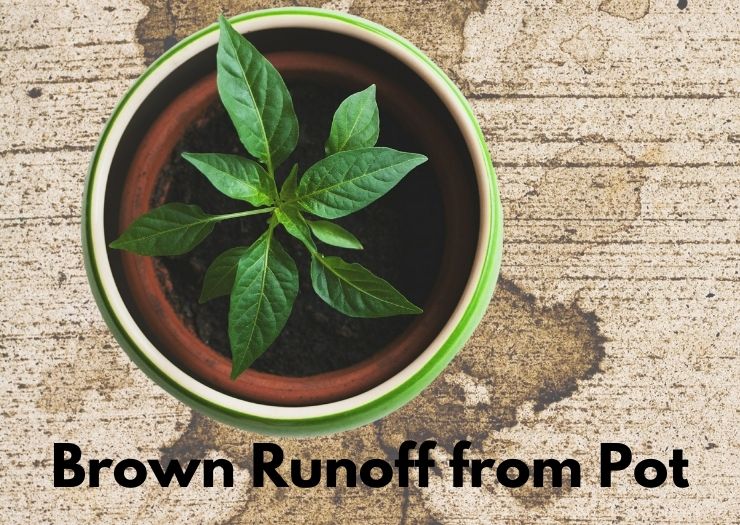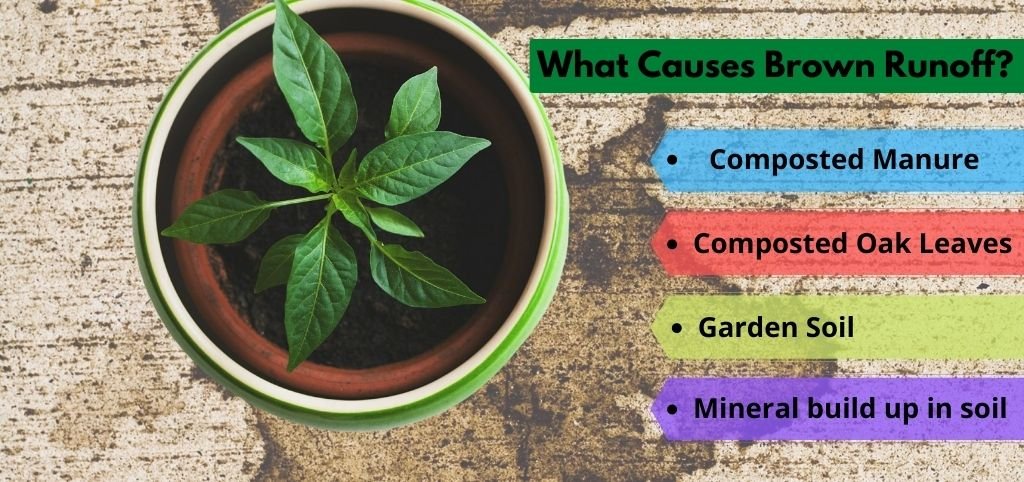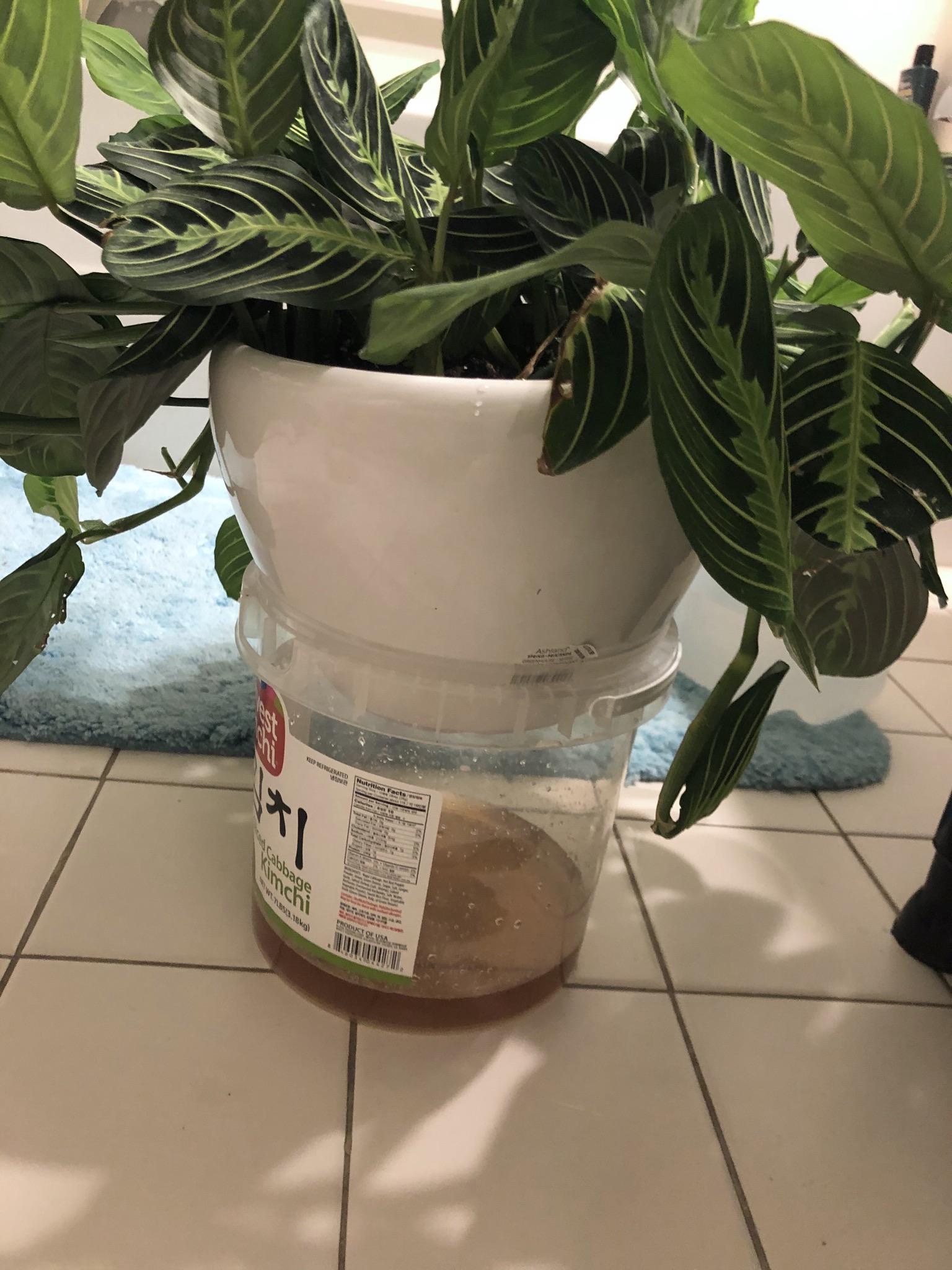
In our homes, potted plants offer color and freshen the air. When watered, these potted plants can make a mess, particularly if there is brown drainage coming from the pot.
The components of the soil are mostly to blame for the brown runoff from potted plants. The majority of the time, the soil will be made up of decomposing organic material, such as clay, composted manure, or oak leaves, which can all cause water to turn dark as it passes through and out of the soil. If this dark discharge is let to stand for too long, it may discolor the floors.
On your patio, the brown drainage from the plants may leave unsightly and difficult-to-remove stains.
This article will explain what causes brown runoff and how you may stop it from becoming a mess if you are also having problems with it.
There are a lot of nice soil alternatives available if you plan to repot your plant, but I’ve found that this Miracle-Gro potting soil from Amazon is the most reasonably priced and successful at keeping my plants healthy long after repotting. Clicking here will take you there.
Table of Contents
What Causes The Brown Runoff From Plants When Watered?

There are several causes of brown or rusty discharge after watering. The following lists a handful of them:
Homemade Compost Containing Oak Leaves
Brown runoff can be caused by oak trees’ tannin. According to the U.S. Department of Agriculture (USDA), the water-soluble polyphenol tennin may aid in enhancing soil quality.
Oak leaves are frequently used by gardeners in their compost because of their many advantages.
Oak leaves may be the main cause of brown runoff if you use them in your compost mulch, too.
To Fix It:
Repot your plant if you want the brown runoff to stop. This time, though, avoid including oak leaves in your compost mulch.
Water frequently till you notice that the water is coming out much cleaner if you don’t want to repot.
Put the pot in a saucer or other pot once you see clear water starting to flow in order to drain any extra water and avoid root rot.
NOTE: Mix one gallon of water with bleach to get rid of the tenacious dark stains.
Composted Manure
Brown runoff can also be brought on by composted manure. Rusty or brown discharge may result from even a tiny addition of composted manure.
Fertilizer Residue or Salt Buildup
Brown or rusted runoff can also be brought on by salt buildup and fertilizer residue.
Your roots in the bottom of the pot may absorb water minerals over time. Consequently, it is advised to water plants with water that has come from a reputable source.
The water you use to water your plants can have a variety of effects on them, including this brown discharge.
The compounds in fertilizers operate similarly. Brown runoff may be caused by the fertilizer you are applying if it contains manganese, iron, or copper.
To Fix It:
Flush your pot with distilled water many times to remove the salt, mineral, and fertilizer buildup. Hopefully, your pot will have a clearer discharge after three or four flushes.
Misting while applying fertilizer is another efficient approach to make sure the soil doesn’t have too much salt, which can accumulate over time.
Other Organic Components in The Potting Soil
Brown runoff can also be brought on by organic components in potting soil. Wash your hands thoroughly to solve the issue.
Overwatering
Overwatering is a frequent cause of brown runoff.
Overwatering and underwatering are typically the most frequent issues that plants encounter. Some gardeners, especially novices, like watering their plants.
It’s simple to rush and add more water to the pot than is necessary when the soil is dry.
When you overwater a plant, a significant amount of the water settles towards the roots at the bottom of the pot, which causes root rot and plant death.
To Fix It:
At the bottom of the pot, add some rocks to stop brown runoff and damp feet.
Since the rocks have huge pore spaces that prevent water collection, they aid in drainage at the pot’s bottom.
Garden Soils
The water drains as brown if your plants are potted in garden soil (dirt + water = brown runoff).
Different types of rocks, minerals, plants, and animal remains are said to have this brown color.
To Fix It:
To avoid brown runoff, you can water your plants using the bottom watering method.
My plants stay healthy even after repotting thanks to the Miracle-Gro Potting Mix I get from Amazon. Clicking here will take you there.
How To Keep Plants With Drainage Holes From Making a Mess?

By using plant saucers, you may reduce the potential mess that potted plants may create.
Gardeners often place a type of deep plate beneath their plant pots to collect or gather the water that has been drained from the pots.
The majority of the water you feed plants drains out of the drainage holes at the bottom of the plant pot, so they don’t use all of it.
What prevents the water from spilling and leaving a mess on your floor is a saucer.
Different techniques can be used to eliminate the brown runoff that collects in the saucer after draining from the drainage hole.
The Benefits of Having a Plant Saucer:
Typically used with plant pots or containers, plant saucers are used to collect and keep extra water that has drained out of the plant after it has been watered.
The saucer will catch the brown flow and keep your patio or floor from getting stained.
Most plant pots come with saucers, but if you need to buy one, I’d advise looking for one that complements the pot and can contain enough water.
Holds The Excess Water
Both indoor and outdoor plants can benefit from the use of saucers to prevent a brown runoff problem everytime the plant is watered.
This is so that the brown runoff from each time you water your plants can enter the saucer through the drainage hole and condense inside the saucers.
The contaminated water can then be easily drained from the saucer. You can keep your floor from getting stained by taking the extra water out of the saucer. To recycle soil minerals that have been washed away, this water can be added once again to the plant.
See our in-depth post on how to drain a plant saucer of extra water.
Prevent Insects From Nesting
By placing a water barrier between the ants and your plants, you can stop them from damaging your plants.
The soil combination and foliage of your plants can suffer severe harm from insects. Bugs, spider mites, and other insects can find food in plant leaves.
Even some of the insects lay their eggs in the potting soil, such snails and ants. A little carelessness on your part, and an army of insects will overrun your plant.
Increase Humidity
Saucers are a terrific technique to boost humidity for plants and make less mess inside the house.
Plants like the Birds nest fern that require more humidity to thrive would do best in a pot with a plant saucer.
Water should then be added to the saucer, along with some stones and pebbles, to provide the plants a decent amount of humidity.
How To Clean Plant Stains From The Floor?
The dark drainage from your plants has left stains on the floor that can be removed in a number of methods.
Stains From Fertilizer Residue
The stains left behind by fertilizer residue—which sometimes contains copper, manganese, or iron—leave the concrete floor looking bluish-green or brown. These are the methods you can use to get rid of the stains:
- Make a paste out of four cups of white vinegar, one teaspoon of salt, and one cup of flour. Apply the mixture to the stains and allow it to settle for 30 to 60 minutes. Rinse completely after using warm water and a soft scrub.
- Lemon, Salt, and Baking Soda: To produce a paste, combine two spoons of lemon juice with one teaspoon of salt. Use a gentle cloth or brush to rub the paste. After a brief interval, rinse with warm water, then pat dry.
- Warm Soap and Warm Water: Scrub the stains clean with warm soap and warm water if they are not difficult to remove.
I would suggest Osmocote Smart-Release Plant Food if you’re looking for a fertilizer that will make sure your plant grows healthily for a long period with no involvement. Clicking here will take you there.
In Case of Dirt, Salt, or Mineral Build-up
Use the following techniques if the stains are brought on by salt or mineral runoff:
- Solution of Bleach and Water: Combine a small amount of bleach with one gallon of water. Clean the floor with a soft brush and lukewarm water.
- Mineral deposits on concrete floors can be softened and removed with vinegar and paper towels by covering the deposits with vinegar-soaked paper towels for at least one to two hours.Dry after rinsing with warm water.
The Takeaway:
In conclusion, a variety of factors, such as salt/mineral buildup, fertilizer residue, composted manure, homemade compost mulch created with oak leaves, garden soil, or overwatering, might contribute to brown discharge from plant pots.
By utilizing a plant saucer, you may stop brown runoff from making a mess.
All the filthy extra water that drains from the pot will be collected in a plant saucer, keeping your floor stainless.
FAQ
Can you water plants with dirty water?
Can you use dishwater, bathwater, or laundry water to water outside plants if there isn’t any fresh water available due to a drought? If you take reasonable precautions, yes.
Can I water plants with old water?
Before using tap water to water your plants, let it sit out for at least 24 hours to lessen the possibility of dangerous compounds in the water. The chlorine can now disperse as a result.
Can you water plants with old water?
Before using tap water to water your plants, let it sit out for at least 24 hours to lessen the possibility of dangerous compounds in the water. The chlorine can now disperse as a result.
Why is my plant draining brown water?
A multitude of factors, including salt/mineral buildup, fertilizer residue, composted manure, homemade compost mulch created with oak leaves, garden soil, or overwatering, might contribute to brown discharge from plant pots.
